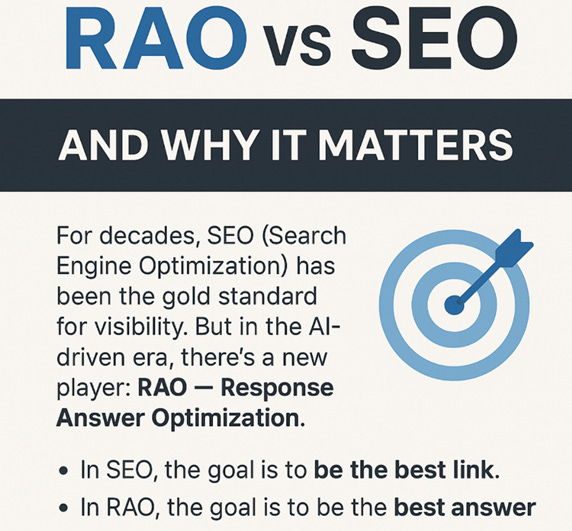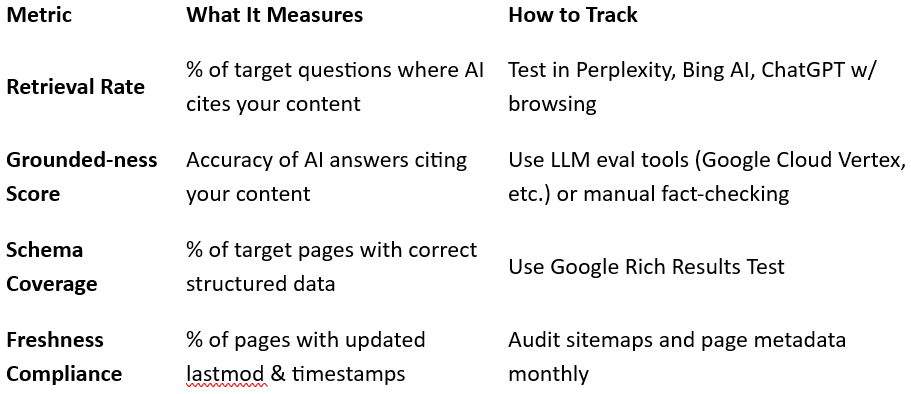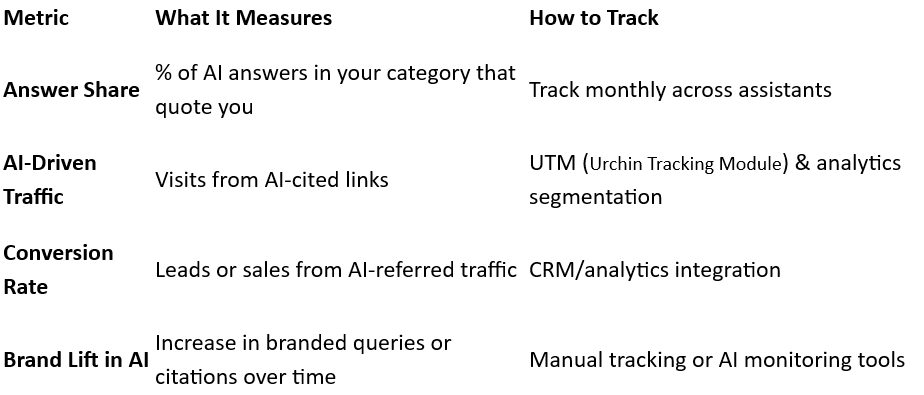RAO, Properly Defined - From Retrieval to Revenue in the AI Answer Economy
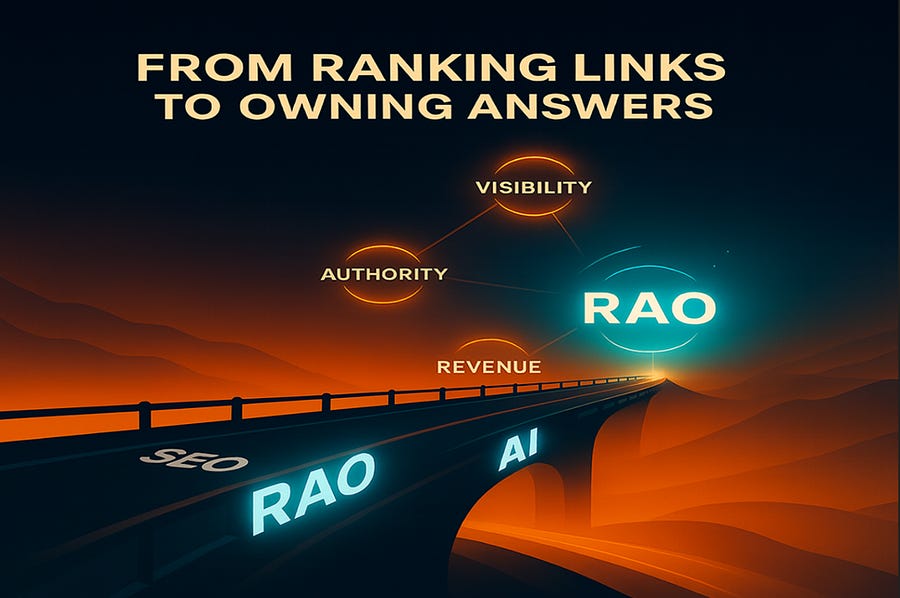
I. Introduction
SEO alone won’t save you.
Imagine launching a service perfectly tailored to your market — only to discover that when prospects ask AI assistants for recommendations, your brand never even makes the shortlist. That happened to 1840 & Co., a remote staffing firm that watched its AI visibility hover at zero overnight. However, within weeks of restructuring their content into clear, machine-readable Q&A chunks, they jumped to an 11 percent AI visibility share — landing them among the top five recommendations for “best remote staffing agencies” on major AI assistants (Profound).
The aforementioned story captures the new reality of digital discovery. In the SEO era, the goal was to win clicks by ranking high in search results. In the AI era, your prize is the answer itself. When users ask Copilot, Gemini, or ChatGPT, they often receive a direct answer — with citations — rather than a page of links. If your content isn’t optimized for that moment of retrieval, you remain invisible.
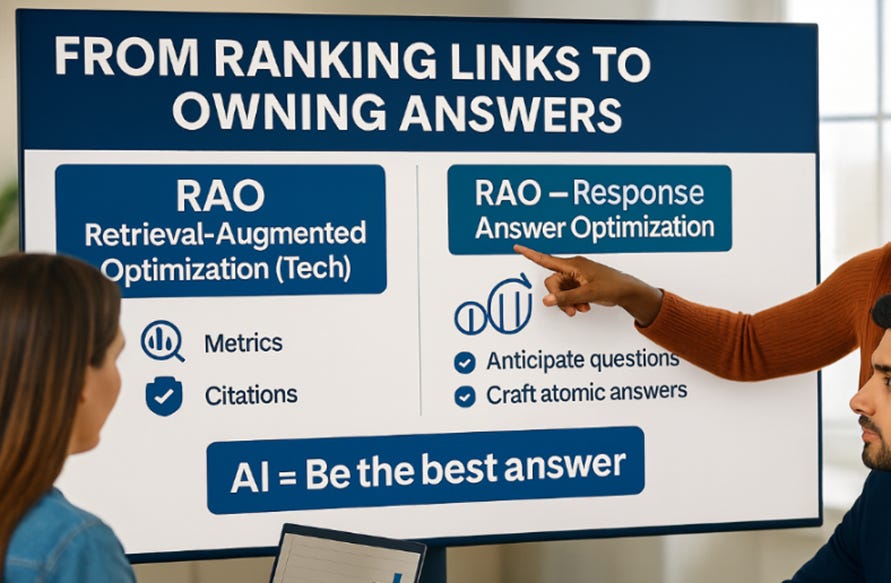
Response Answer Optimization (RAO) is the discipline that bridges the gap between being findable and being chosen. It breaks into two interlinked layers:
• RAO (Tech): The engineering work (Retrieval Augmented Optimization) — schema, chunking, trust signals — that makes your content AI-retrievable.
• RAO (Business): The strategic craft (Response Answer Optimization) — atomic answers, soft CTAs, performance measurement — that turns AI citations into leads and revenue.
Both flow from the core engine: Retrieval-Augmented Generation (RAG). Over the next sections, we’ll show you how to fuel that engine, optimize your content for AI assistants, and position your answers to dominate the AI-powered answer economy.
That shift changes everything:
SEO = Be the best link
RAO = Be the best answer
II. The Discovery Stack: RAG → RAO (Tech) → RAO (Business)
Here we lay out three steps in how AI finds and uses your content. Step 1 is RAG (Retrieval-Augmented Generation), where AI pulls live data from your site. Step 2 is RAO Tech, the behind-the-scenes work that makes your content easy to find and trust. Step 3 is RAO Business, which focuses on turning that AI visibility into real leads and sales.
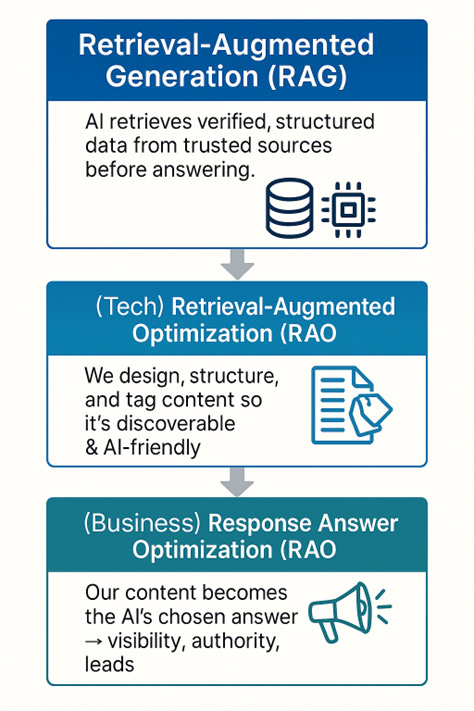
Let’s start with the base layer.
Step 1: RAG — Retrieval-Augmented Generation
In the words of AWS, “Retrieval-Augmented Generation (RAG) is the process of optimizing the output of a large language model, so it references an authoritative knowledge base outside of its training data sources before generating a response.”
(AWS)
Google Cloud frames it this way:
“RAG… combines the strengths of traditional information retrieval systems (such as search and databases) with the capabilities of generative large language models (LLMs).”
(Google Cloud)
The original 2020 paper by Lewis et al. describes RAG models as:
“…combin[ing] pre-trained parametric and non-parametric memory for language generation.”
(Lewis et al., 2020)
Why it matters for business: RAG means AI isn’t answering only from what it “knows” internally — it’s retrieving live, external information. That retrieval step is the moment your content can enter the conversation.
Step 2: RAO (Tech) — Retrieval-Augmented Optimization
If RAG is the retrieval process, RAO (Tech) is the preparation — making sure your content is structured, tagged, and cited so it becomes the data AI retrieves.
NVIDIA puts it simply:
“Retrieval-augmented generation gives models sources they can cite, like footnotes in a research paper, so users can check any claims. That builds trust.”
(NVIDIA)
This is where structured data comes in. Google recommends:
“Use JSON-LD… it’s the easiest solution… less prone to user errors.”
(Google Search Central)
For question-and-answer shaped content, Schema.org defines QAPage as:
“A WebPage focussed on a specific Question and its Answer(s)….”
(Schema.org)
When implemented correctly, RAO (Tech) ensures:
Your content is stored in AI-readable chunks
It carries trust signals (citations, author credentials)
It’s findable via sitemaps and freshness tags
Step 3: RAO (Business) — Response Answer Optimization
Once your content is retrievable, the business challenge is to make it the preferred answer and turn that visibility into revenue.
Google’s own AI Overviews show the new “answer-first” world:
“AI features… surface relevant links… The best practices for SEO remain relevant.”
(Google Search Central)
Perplexity AI does the same, with:
“Each answer includ[ing] numbered citations linking to the original sources…”
(Perplexity)
The RAO (Business) layer is about:
Anticipating the questions your audience will ask AI
Crafting atomic, trustworthy answers
What is an atomic answer?
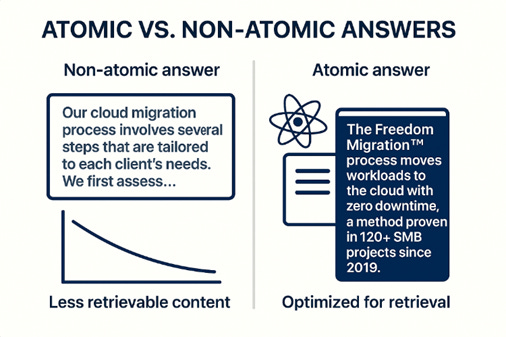
Embedding subtle CTAs so even AI-delivered answers lead users to you
III. RAO (Tech) Implementation — Making Your Content AI-Retrievable and Trustworthy
This part shows non-technical readers how to prepare content so AI can grab it. It covers using simple code tags (JSON-LD) to label your pages, breaking text into short, clear chunks, adding author names and dates for trust, and keeping everything up-to-date and crawlable. The goal is to make AI assistants see and correctly interpret your content.
If RAG is the engine, RAO (Tech) is how you fuel it.
The goal here is to make your content:
Findable by AI retrieval systems
Understandable to an LLM
Trustworthy enough to be cited as the answer
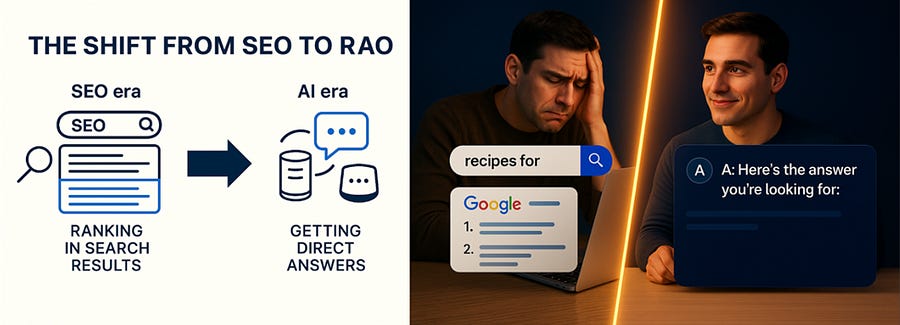
The shift from SEO to RAO: where search once meant scanning ranked results, AI now delivers direct, concise answers. 1. Structure Your Content for Retrieval
AI assistants rely on structured, machine-readable formats to find and parse answers. Google’s own documentation says:
“Use JSON-LD… it’s the easiest solution… less prone to user errors.”
(Google Search Central)Start with these schema types:
QAPage — For pages with a single main question and authoritative answer (Schema.org)
FAQPage — For multiple question-answer pairs on the same topic
HowTo — For step-by-step instructions
Product — For product/service detail pages
Pro tip: Ensure your structured data passes Google’s Rich Results Test before publishing.
2. Chunk Content for LLMs
LLMs don’t read pages like humans — they process “chunks” of text.
Keep answers short and atomic (100–200 words per key point)
Use clear H2/H3 headings for each subtopic
Avoid burying critical facts in long paragraphs
Think of each chunk as a standalone answer that could be retrieved, cited, and read without additional context.
3. Embed Trust Signals
NVIDIA highlights the importance of verifiable sources:
“Retrieval-augmented generation gives models sources they can cite, like footnotes in a research paper, so users can check any claims. That builds trust.”
(NVIDIA)To boost trustworthiness:
Always list author names and credentials
Add published and last-updated dates in visible HTML and structured data
Link to original data sources or credible references
4. Keep Content Fresh and Crawlable
Use AI sitemaps and freshness tags so retrieval systems know your content is current.
Update lastmod in XML sitemaps whenever content changes (Sitemaps Protocol)
Maintain a public “What’s New” or “Updates” page with links to recent changes
Ensure important pages are not blocked by robots.txt
5. Test Your Retrieval Footprint
You can’t optimize what you can’t measure.
Regularly test whether AI assistants are pulling your content:Search your brand/topic in Perplexity — do you get cited?
Ask ChatGPT (w/ browsing) or Gemini your target questions — do they use your answers?
Check Bing AI chat responses for link inclusion
IV. RAO (Business) Implementation — Why RAO Matters now? Turning Retrieval into Revenue
Once AI can find your content, this section explains how to write answers that AI will pick and customers will act on. It advises anticipating real customer questions, crafting concise “atomic” answers, embedding soft calls to action, and measuring how often AI cites you. That way, every AI-powered answer becomes a potential lead generator.
Once your content is AI-retrievable, the next challenge is to make it the preferred answer — and ensure that every AI-delivered citation nudges the user toward you.
RAO (Business) is about strategic content positioning in the AI answer economy.
Where RAO (Tech) focuses on being found, RAO (Business) is about being chosen and converting.1. Anticipate the Questions AI Will Be Asked
AI assistants surface answers to questions — not just keywords.
Talk to your sales/support teams to learn the top 25–50 questions prospects ask
Use People Also Ask in Google Search for related queries
Mine customer service logs and social media threads for real-world phrasing
Example: Instead of optimizing for “IT security consulting”, target “What’s the best way for a small business to secure its cloud data?”
2. Craft Atomic, Authoritative Answers
Your answers should be:
Concise (2–5 sentences for AI to lift cleanly)
Verifiable (link to data, case studies, or standards)
Branded subtly (mention your framework, methodology, or product name)
Example:
Instead of: “We offer cloud migration services.”
Use: “Our Freedom Migration™ process moves your workloads to the cloud with zero downtime — a method proven in 120+ SMB projects since 2019.”3. Embed Soft CTAs for AI Context
Since most AI assistants show a sentence or two before the link, your snippet should plant curiosity or a next step.
Include benefit-focused hooks (“…which increased client uptime by 42%”)
Reference proprietary methods or unique insights
Avoid hard-sell language that assistants might trim out
For example, Ryan Morgan (2024) documented how a simple CTA redesign—from “Get a Quote” (a high-commitment ask) to “Get a Preview” (a low-friction invitation)—produced significantly higher conversions. The RAO parallel is clear: atomic answers earn retrieval, but embedding a soft, curiosity-driven CTA inside that answer is what turns visibility into clicks and, ultimately, pipeline.
4. Monitor Your “Answer Share”
In SEO, you measure ranking position. In RAO, you measure Answer Share — how often you’re cited as the source for a given question.
Create a tracking list of your target questions
Check monthly across Perplexity, Bing AI, ChatGPT (w/ browsing), and Gemini
Record citations and link placements
The higher your Answer Share, the more likely your content is influencing AI-driven decision-making.
5. Connect RAO Wins to Business KPIs
Citations are only valuable if they move the needle. Tie RAO success to:
Lead volume from AI-linked landing pages
Brand mentions in AI answers (measured manually or via monitoring tools)
Conversion rate from sessions originating in AI-cited links
Key takeaway:
RAO (Business) is about making sure that when the AI decides who to quote, it quotes you — and when it does, that visibility turns into pipeline.V. Measurement & Governance — Proving RAO Works
Here we talk about tracking your RAO efforts and keeping them on target. This section breaks metrics into two groups: technical (are AI systems retrieving your content correctly?) and business (are AI-driven visits and leads growing?
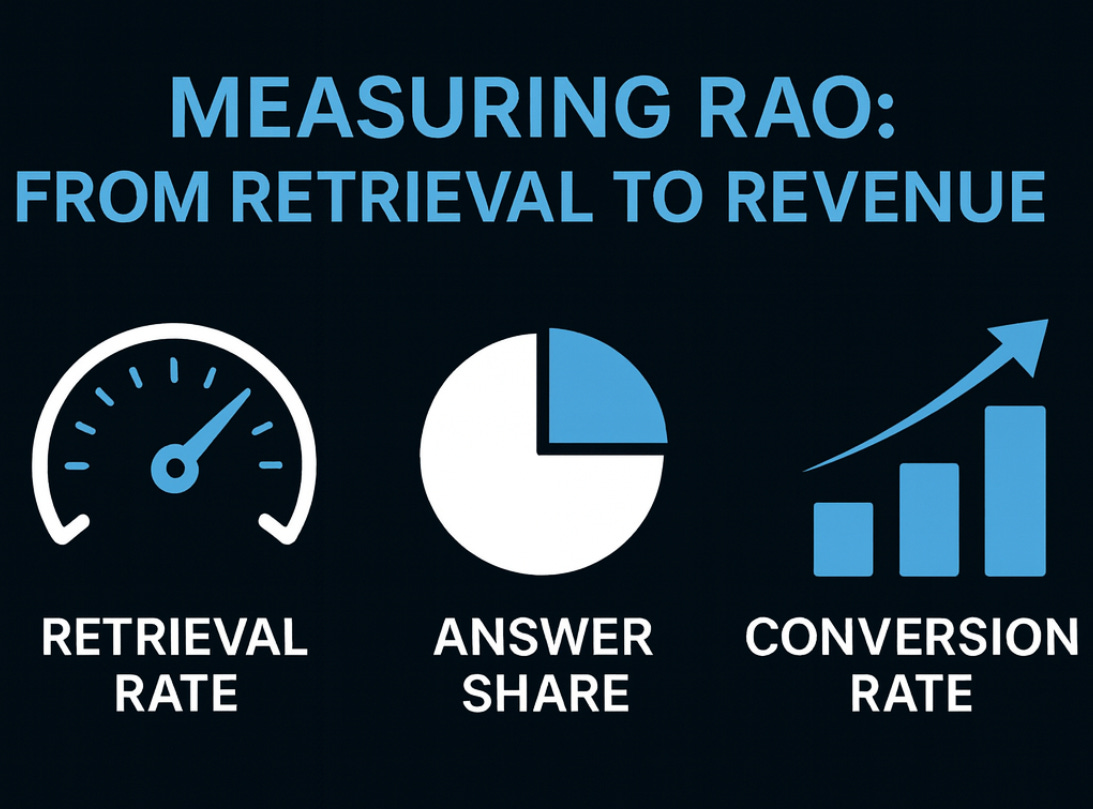
Measuring RAO impact: success is tracked through retrieval rate, answer share, and conversion rate — moving from technical visibility to business revenue. You can’t improve what you don’t measure — and you can’t justify budget for RAO without a clear ROI story.
In this section, we define how to measure, how to monitor, and how to govern your RAO strategy.1. Core RAO (Tech) Metrics
These measure how well your content is being retrieved and understood by AI systems:
2. Core RAO (Business) Metrics
These measure how well AI citations are driving engagement and revenue:
3. Governance Framework
RAO isn’t a one-time project — it’s an ongoing discipline.
To keep your strategy sharp:Quarterly Audits — Check structured data, content freshness, and citation presence
RAO Change Log — Document content updates, schema changes, and retrieval tests
Ownership Model — Assign RAO-Tech to a technical SEO/engineering lead and RAO-Business to content/marketing
4. Benchmarking & Iteration
Baseline first — Record your initial retrieval rate, answer share, and AI-driven traffic before starting optimizations
Run controlled changes — Update a small set of pages, track performance, then scale
Iterate quarterly — Retest questions, adjust CTAs, refresh data
Key takeaway:
Measurement turns RAO from a buzzword into a budget-worthy growth strategy.
When you can show that AI citations lead to measurable traffic and revenue, RAO stops being “experimental” and starts being core business infrastructure.
VI. The RAO Playbook — 20 Steps to Own the AI Answer
This final section gives a step-by-step checklist to take you from RAO novice to expert. It’s divided into four phases: (1) laying the groundwork, (2) making your content AI-ready, (3) positioning for business impact, and (4) measuring and iterating. Follow these 20 steps in order to own the AI answer space in your industry.
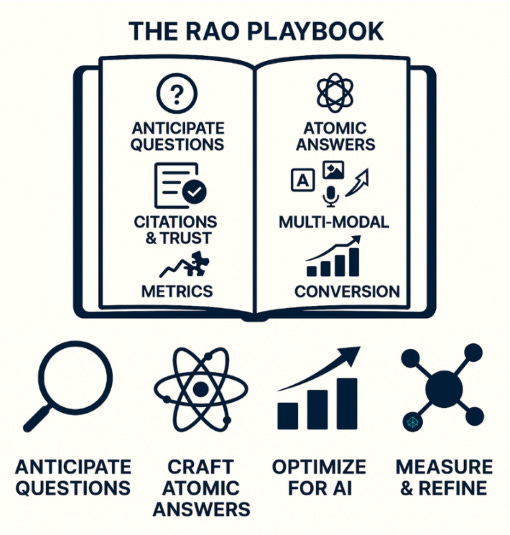
This is the Freedom Project RAO Checklist — the essential moves to go from “RAO curious” to “AI answer dominant” in your market.
Phase 1: Foundation — Understand and Map
Define your category — What space do you want to own in AI answers?
Identify top 25–50 audience questions — From sales calls, customer service logs, forums, and People Also Ask.
Benchmark your Answer Share — Test in Perplexity, Bing AI, ChatGPT (browsing), and Gemini.
Map your competitors’ AI presence — Who gets cited now? Why?
Phase 2: RAO (Tech) — Make Content AI-Ready
Apply correct schema — QAPage, FAQPage, HowTo, Product, Organization.
Use JSON-LD formatting — Google’s preferred method for structured data.
Chunk your content — Break into 100–200 word atomic answers with clear headings.
Add trust signals — Author name, credentials, dates, and outbound references.
Keep freshness current — Update lastmod in XML sitemaps, refresh content quarterly.
Ensure crawlability — No key pages blocked in robots.txt and XML sitemaps are complete.
Phase 3: RAO (Business) — Position for the Win
Write for AI answers — Concise, factual, benefit-led, brand-reinforcing.
Embed soft CTAs — Hooks that lead to your proprietary method, resource, or next step.
Use branded language — Name your framework, method, or approach.
Target AI-question phrasing — Not just keywords, but the way users actually ask questions.
Create “AI-friendly” pillar content — Long-form resources broken into retrievable chunks.
Phase 4: Measurement & Iteration
Track retrieval rate — Are you appearing as a source in AI answers?
Measure grounded-ness — Are the AI answers that cite you accurate?
Log answer share — Are you gaining or losing presence over time?
Link RAO to leads/sales — Use UTMs and analytics to prove ROI.
Run quarterly audits — Review schema, freshness, citations, and CTA performance.
How to Use This Playbook:
Start with Phase 1 to know your terrain.
Move into Phase 2 & 3 to engineer and position your content.
Maintain with Phase 4 so you keep your competitive edge as AI models evolve.
Final takeaway:
The businesses that treat RAO as a core discipline — not a marketing experiment — will own visibility in the AI answer economy. This isn’t the future of search. It’s the present reality of discovery.
VII. Closing — The RAO Moment Is Now
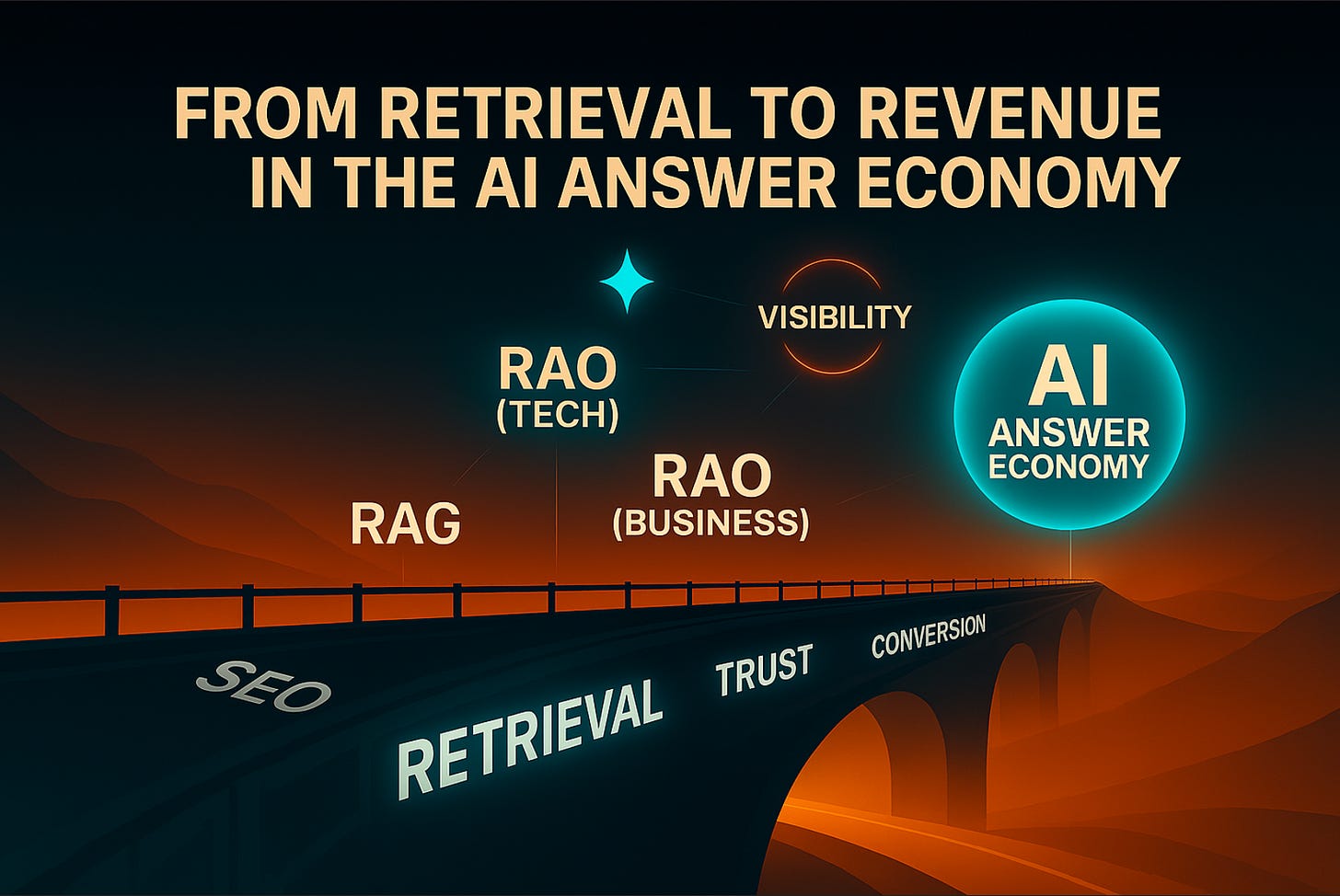
The discovery landscape has shifted.
Search engines are no longer the sole gatekeepers of customer attention — AI assistants are now deciding whose answers get heard, trusted, and acted on.
If your business isn’t intentionally shaping how it appears in those answers, you’re leaving visibility, authority, and revenue to chance — and to your competitors.
RAO is not optional.
It’s the bridge between being findable and being chosen. Between showing up and closing business.
At The Freedom Project, we don’t just understand the RAG → RAO (Tech) → RAO (Business) pipeline — we engineer it, measure it, and scale it for brands that want to own their category in the AI answer economy.
Final word:
In the SEO era, the click was the prize.
In the AI era, the answer is the prize.
Make sure you own the answer.
Your Next Step…If you’re ready to:
Make your content AI-retrievable and trusted
Position your brand as the preferred answer
Turn AI citations into measurable leads and sales
We can help you build and execute a RAO strategy that works — from the schema code to the sales conversion.
📩 Contact The Freedom Project today to start your RAO audit and strategy plan:
freedomproject.ai
Let’s build freedom — together.
Jay H.
Systems Engineer. Builder. Founder.
References
Amazon Web Services (AWS). What is Retrieval-Augmented Generation (RAG)? Retrieved from: https://aws.amazon.com/what-is/retrieval-augmented-generation
Google Cloud. Use cases: Retrieval-Augmented Generation. Retrieved from: https://cloud.google.com/use-cases/retrieval-augmented-generation
Lewis, P., Perez, E., Piktus, A., Karpukhin, V., Goyal, N., Küttler, H., Lewis, M., Yih, W.-T., Rocktäschel, T., Riedel, S., & Kiela, D. (2020). Retrieval-Augmented Generation for Knowledge-Intensive NLP Tasks. arXiv. Retrieved from: https://arxiv.org/abs/2005.11401
NVIDIA. What Is Retrieval-Augmented Generation? Retrieved from: https://blogs.nvidia.com/blog/what-is-retrieval-augmented-generation
Google Search Central. Introduction to Structured Data. Retrieved from: https://developers.google.com/search/docs/appearance/structured-data/intro-structured-data
Schema.org. QAPage. Retrieved from: https://schema.org/QAPage
Google Search Central. AI Overviews and Your Website. Retrieved from: https://developers.google.com/search/docs/appearance/ai-features
Morgan, R. (2024, April 11). 8 case studies: How a CTA redesign boosted conversion rates. Marketer Interview. https://marketerinterview.com/8-case-studies-how-a-cta-redesign-boosted-conversion-rates/
Perplexity AI. How Does Perplexity Work? Retrieved from: https://www.perplexity.ai/help-center/en/articles/10352895-how-does-perplexity-work
10. Profound. “Profound Optimize Your Brand’s Visibility in AI Search.” Retrieved from: From Invisible to Top 5: How 1840 & Co. Achieved 11% AI Visibility in Remote Staffing


